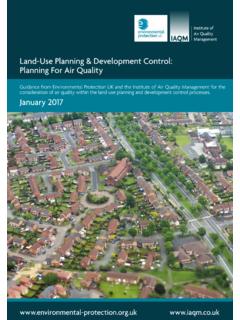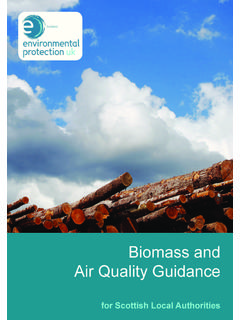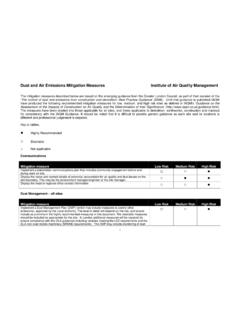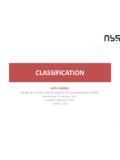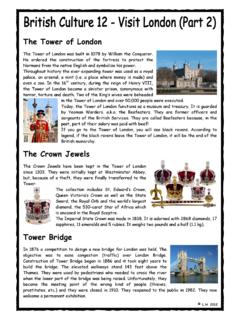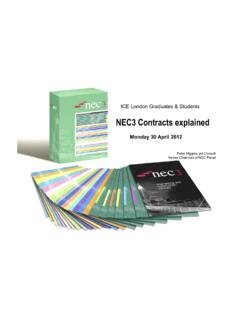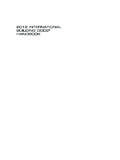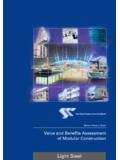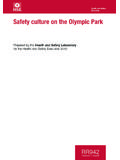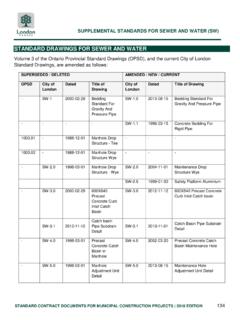Transcription of Guidance on Air Quality Monitoring in the Vicinity …
1 IAQM u Guidance construction DustGuidance on Air Quality Monitoring in the Vicinity of demolition and construction u Guidance construction Dust21. Introduction 2. Background 3. Methodology for the Development of this Guidance 4. Glossary of Terms 5. Approach to Air Quality Monitoring6. Case study: Barts and London NHS Trust7. Case study: East Parkside, Greenwich 8. Appendix 4 5 6 Contents21238197 IAQM Guidance on Air Quality Monitoring in the Vicinity of demolition and construction Sites 3 IAQM u Guidance construction DustAcknowledgmentsAuthor: Steve MoorcroftEditor: Emma FentonGraphic Design: Aoife O Connell IAQM committee & experts who offered their comments during the preparation of this document.
2 Richard Maggs at Bureau Veritas for providing the Case Study for Barts and London NHS Trust, and Hugh Datson at DustScan for providing the Case Study related to East Parkside, Greenwich. About the Institute of Air Quality Management (IAQM): The mission of the Institute of Air Quality Management is to be an authoritative voice by maintaining, enhancing and promoting the highest standards of working practices in the field of air Quality and for the professional development of those who undertake this work. About the Institution of Environmental Sciences (IES): The IES is a visionary organisation leading debate, dissemination and promotion of environmental science and sustainability.
3 We promote an evidence-based approach to decision and policy making. We are devoted to championing the crucial role of environmental science in ensuring the well-being of humanity now and in the charity no. 277611 Copyright statement: Copyright of the published materials is held by the Institution of Environmental Sciences. We encourage the use of the materials but request that acknowledgement of the source is explicitly : Institution of Environmental Sciences 34 Grosvenor Gardens London SW1W 0DH T: +44 (0)20 7730 5516 E: credit: Roger Barrowcliffe (RWDI)IAQM u Guidance construction Dust41. The Institute of Air Quality Management (IAQM) is committed to enhancing the understanding and development of the science behind air Quality by promoting knowledge and understanding of best working practices.
4 Membership of IAQM is mainly drawn from practicing air Quality professionals working within the fields of air Quality science, air Quality assessment and air Quality management. Constructing buildings, roads and other infrastructure can have a substantial, temporary impact on local air Quality . The most common impacts are increased particulate matter (PM) concentrations and dust soiling. Depending on the risk of dust effects occurring, Monitoring may need to be carried out during both demolition and construction activities to ensure that the applied mitigation measures are effective in controlling dust emissions, and that there are no significant impacts on the surrounding environment.
5 This Guidance on air Quality Monitoring in the Vicinity of demolition and construction sites has been produced as a result of the voluntary contribution of the members of a Working Group, for which IAQM is very grateful. The Working Group members were:Chair Stephen Moorcroft (Air Quality Consultants)Drafting Sub GroupHugh Datson, DustScan LtdPeter Fleming, TRLD aniel Marsh, Kings College LondonMatthew Stoaling, SLR ConsultingUseful comments were also received from:Duncan Laxen, Air Quality IAQM is also grateful for the co-operation of the Greater London Authority in developing this Guidance . IAQM Guidance on Air Quality Monitoring in the Vicinity of demolition and construction Sites 5 IAQM u Guidance construction Environmental Impact Assessment (EIA) requires the consideration of any impacts associated with the demolition / construction phase of a proposed development.
6 Such considerations are also frequently incorporated into a variety of other air Quality assessments. These assessments often need to consider the role of air Quality Monitoring within the package of mitigation measures that is proposed, and such Monitoring proposals are frequently incorporated into s106 legal agreements. In 2006, the Greater London Authority (GLA) with the London Councils produced The Control of Dust and Emissions from construction and demolition : Best Practice Guidance , with the assistance of BRE and others. This Guidance has been widely used to develop measures to be applied to control dust at construction sites, even outside London. The Guidance includes information on site Monitoring protocols and air Quality Monitoring techniques, and when these should be applied.
7 The Mayor of London committed to updating this Guidance in his 2010 Air Quality Strategy. Since the GLA Best Practice Guidance was published, there have been changes to Monitoring techniques and considerable experience has been gained in the field from construction Monitoring programmes. IAQM has therefore identified the need for new Guidance on Monitoring protocols and This document provides updated Guidance on air Quality Monitoring in the Vicinity of demolition and construction sites. It should be read and applied in conjunction with the Guidance on the Assessment of the Impacts of construction on Air Quality and the Determination of their Significance that was published by the IAQM in January 2012, and with updated Guidance on site evaluation guidelines and mitigation measures that is to be published by the GLA within a Supplementary Planning Guidance .
8 This Guidance is based on the most up-to-date information available, and draws upon the practical experience of the Working Group members, and other contributors, over many years. The evidence related to the development of site action levels applied to both concentrations of particulate matter and dust deposition rates is, however, very limited. Although substantial Monitoring around construction sites has occurred since the GLA Best Practice Guidance was first published, there has been little or no attempt to pull this information together, and the data are not readily accessible within the public domain. The IAQM encourages local planning authorities to make these data public via the s106 legal agreements that are established, so that appropriate future site action levels can be founded on more robust information.
9 This Guidance is not intended to be prescriptive with regard to the various Monitoring techniques that can be used, and instead aims to highlight the advantages and disadvantages of each, in order to assist in the selection of the most appropriate method. Where reference has been made to commercially-available samplers, this is intended to provide additional Guidance on the method and represents no endorsement or recommendation by IAQM. 2. BackgroundPhoto credit: Matt Stoaling (SLR Consulting)IAQM u Guidance construction Dust63. Methodology This IAQM Guidance has been developed through an on-going dialogue within the IAQM and a Working Group established to develop draft Guidance .
10 Suggestions on what should be in the Guidance have been solicited from the Working Group. Once consensus within the Working Group had been achieved on the major issues, the Guidance was circulated to IAQM members for their comments, and these comments have been taken into consideration, and incorporated as far as was reasonably possible. As such, this document represents a recommended approach to Monitoring in the Vicinity of construction sites. It was developed through a collaborative process involving the Institute of Air Quality Management s professional credit: Matt Stoaling (SLR Consulting)IAQM Guidance on Air Quality Monitoring in the Vicinity of demolition and construction Sites 7 IAQM u Guidance construction DustAAC% Absolute Area Coverage The total dust coverage on the sample surface, determined as pixels having a lower greyscale value than a reference value in a computer-scanned image of a sticky pad sample as a % of total Refers to all airborne particulate matter (and is synonymous with the definition of TSP).


